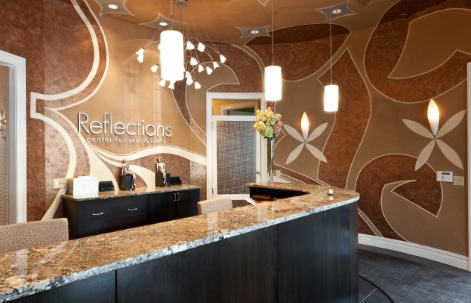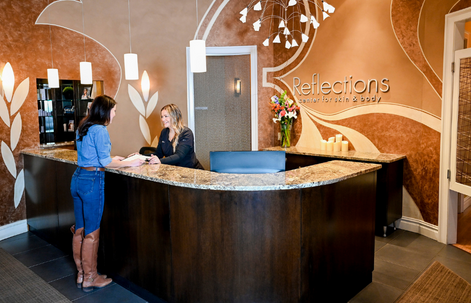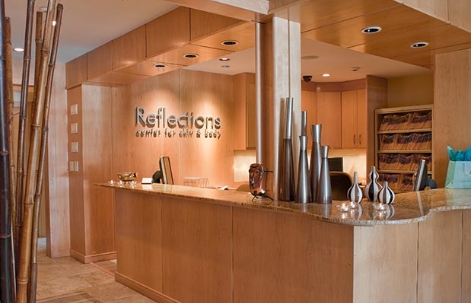We all want to maintain a youthful look for as long as possible. Maybe you’ve kept aging at bay with non-invasive procedures like Botox, fillers, lasers, Ultherapy, or Thermage, but after a certain point, your jawline softens and begins to pool, and the non-invasive procedures that worked before seem to lose their ability to make a difference. Or maybe you didn’t mind when your smile lines were noticeable, but now that they’ve started to droop, you find them unbearable.
Facelift Quick Facts
- Facelifts Address the Cheeks & Jawline (but can be paired with other treatments for other parts of the face)
- Performed by Board Certified Plastic Surgeon
- Can be Local Anesthesia or General Anesthesia Surgery
- Costs $15,000 – 20,000 for Surgeon’s Fees (plus roughly $3,000 for anesthesia and surgery center)
The Modern Facelift

What Causes You to Need a Facelift?
3 types of changes that contribute to an older-looking neck and face:
- Skin Damage – wrinkles, uneven texture, and pigmentation changes, as well as skin laxity and thinning.
- Sagging Muscles – loosening of connective tissues and loss of muscle tone.
- Volume Changes – our necks tend to accumulate more fat as we age, while our faces tend to lose fat.
A Lower Face Lift is the only procedure that addresses changes to all three types of tissues along the lower cheeks and jawline. Your board-certified plastic surgeon will restore muscles and fat to their more youthful positions, creating a more defined jawline. Excess skin will be lifted back into place, reducing pooling and sagging along the jaw. The combination of these three changes will rebuild a solid foundation for a younger appearance for many years to come.
Learn More
Combining Procedures for Maximum Results
Often, by the time patients are ready to address changes in the lower face with surgery, the skin has also undergone significant changes in texture and thickness. For that reason, we commonly pair Lower Facelift with CO2 Ablative Laser Skin Resurfacing, a procedure that addresses skin thickness, texture, discolorations, and sun damage.
Young patients who are interested in addressing mild to moderate aging through the neck and lower face often pair a Lower Face Lift with a Neck Lift. Where a Lower Facelift addresses the jawline and bottom portion of the cheeks, a Neck lift firms and lifts the neck into a more youthful position. These two procedures allow patients to delay larger procedures by many years.
Patients with concerns about a drooping lower face are also usually experiencing some loss of volume in the cheeks and midface. This usually presents as deflating cheekbones and pronounced undereye troughs. Fat Transfer to the midface provides a natural, long-lasting result.
Combining Fat Transfer with Lower Facelift is the modern counterpoint to the old school facelifts, and provides a more sophisticated approach to facial aging, overcoming the wind-blown look of yesteryear.
Learn More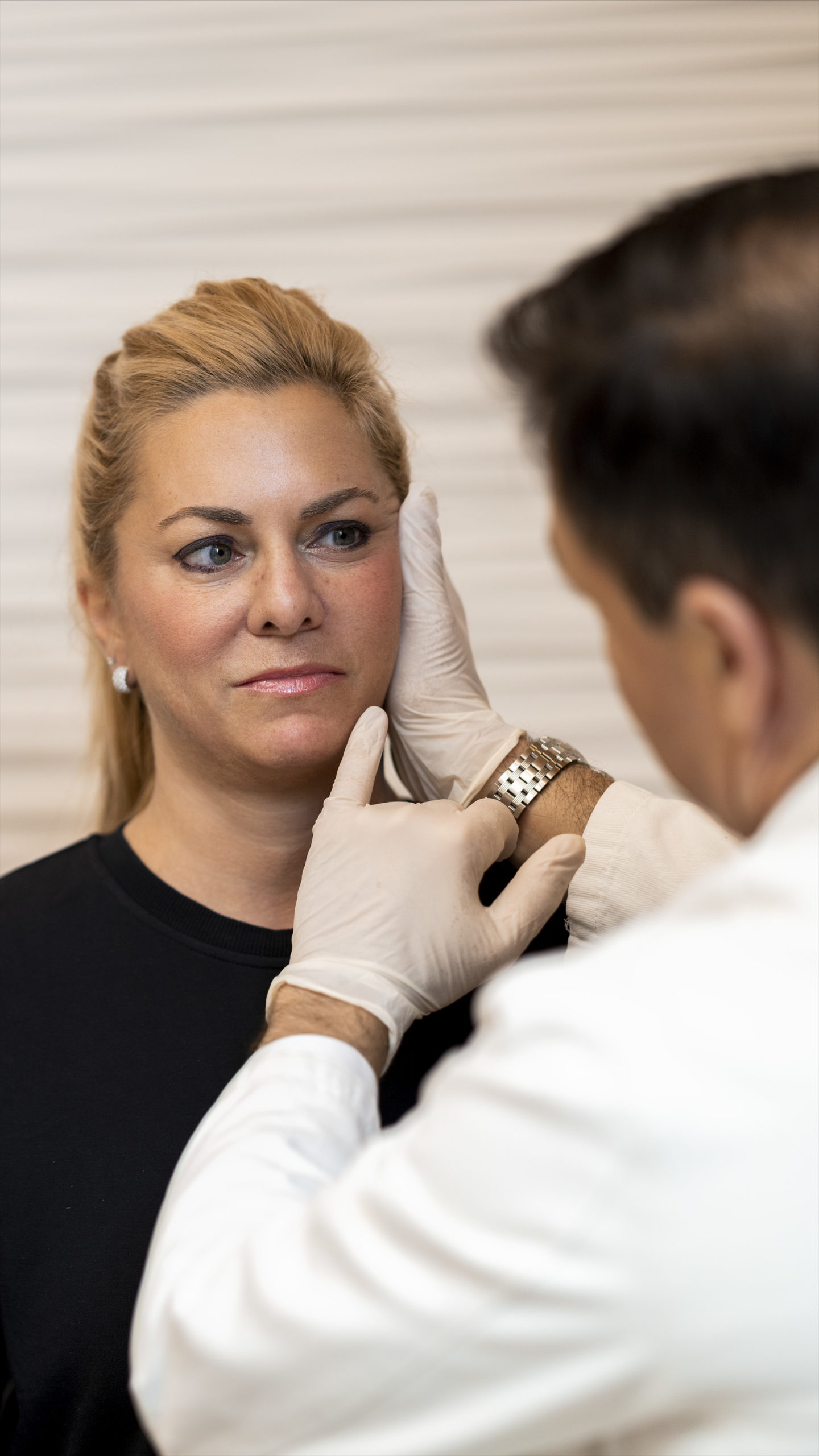

Why Choose Reflections Center For Facelift
Our expert plastic surgery team works collaboratively within our multi-specialty physician team to select the right procedures, providers, and treatment plan for each patient. Our team approach allows our physicians to draw on the expertise of industry leaders in all facets of cosmetic surgery, and in combination with our wide assortment of devices, allows us to hand select not only an effective treatment, but the very best treatment for your physiology, aging patterns, and lifestyle.
At Reflections, our expert physicians will customize proven treatments to meet your cosmetic goals. You will love your new, improved jawline and lifted look! Contact Us to learn more.
Often times, patients will confuse the root causes of aging along their jawline and neck. For this reason, we warmly welcome you to our office for consultation with our dedicated plastic surgeon. His years of experience and deep focus on facial aging allow him to pinpoint the causes, as well as the minimal optimal treatment to effectively turn back the clock on the specific areas you are concerned about.
-
Facial Volumizing Fillers
Facial Volumizing Fillers can be used to temporarily restore volume lost in the cheeks. The most popular brands are Juvederm Voluma, Sculptra, and Restylane Lyft. This is a suitable alternative for those with little change to the underlying muscle, a decreased volume of fat in the midface or across the cheekbones, and only mild to moderate skin laxity.
-
Fat Transfer
Fat Transfer to the midface and cheekbones can provide a longer lasting solution than Facial Volumizing Fillers. Fat Transfer allows the surgeon to use your own fat, usually from your stomach, to replace the fat you’ve lost in your face, or to fill areas that lack volume, in a longer lasting way than traditional fillers. This option is well-suited to those who are suffering more from loose skin due to volume loss than fat accumulation or sagging muscles along the jaw.
-
Ultherapy
Ultherapy is a treatment that uses micro-targeted ultrasound to stimulate collagen and elastin, creating lifting and tightening. This procedure works well for patients who are at the very early stages of aging, and can help delay the need for surgical intervention.
-
Thermage
Thermage is a non-invasive radio frequency treatment that can lift and tone the skin through the jawline, chin, and neck. This treatment can help tighten loose skin most anywhere on the body.
-
Thermitight RF
Thermitight RF is a non-surgical treatment that tightens skin using injectable radio frequency. The results can be quite profound for a non-surgical procedure. However, this option only treats one of the three causes of aging, loose skin, so it is best-suited to those early in the aging process.
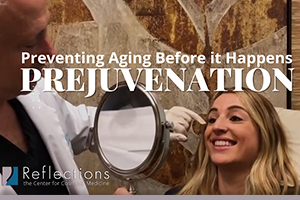
Blog
Prejuvenation: A Step-By-Step Guide
In a huge market of catchy-sounding trends, prejuvenation can seem like just...
Read More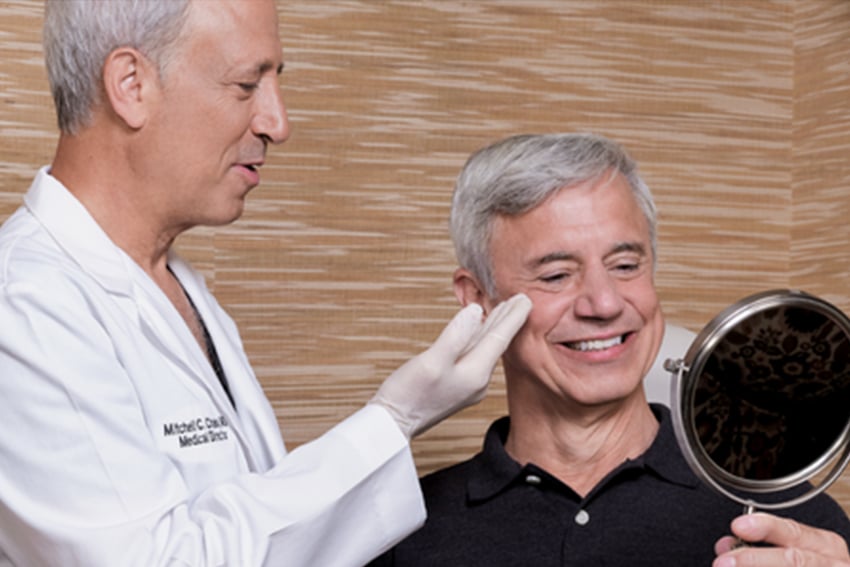
Blog
Need a (Face) Lift?
No matter how hard we beg those hands on the clock to slow down, time keeps...
Read More
Blog
Could Cosmetic Procedures Make Us Happier?
You’ve probably seen the happy, smiling faces used in cosmetic procedure...
Read MoreFrequently Asked Questions About Lower Facelift
- When is the best time to address the lower face with a facelift?
One of the best ways to delay a full-fledged facelift is to strategically restore certain key areas, like the neck and jawline, at an earlier age. Most patients will start to see mild to moderate changes through the lower face and neck by the time they’re in their 40s, if not sooner. Addressing moderate sagging and deflation can turn back the clock, with a smaller procedure. Once you’ve reset to an earlier position in the aging process, you will continue to age in the same way as before; however, this should delay major procedures by several years.
- How is a facelift procedure performed?
First, small incisions are made along the natural intersections of ear, face, and scalp. Muscles and fat that have loosened and are drooping along the jawline are returned to their more youthful positions, higher up in the cheek. Next, skin is gently relaxed back into a more youthful position and excess is trimmed away. Because the surgeon has carefully rebuilt the underlying structures, skin is not tight or pulled, but rather restored to a more natural, smooth positioning across the lower cheeks and jawline.
The location of your incisions, as well as the details that are specific to your unique aging pattern, will be discussed by your board certified facial plastic surgeon at your personalized consultation. However, you can rest assured that you will be well-cared-for and made to feel comfortable throughout the process, and you will find enjoyment in your results for years to come.
- Who is an ideal candidate for a lower facelift?
Almost anyone who wants to turn back the clock on aging along their jawline is a good candidate for a lower facelift. The vast majority of our patients choose this procedure to start their rejuvenation journey. In general, the ideal candidate is someone who:
- Has both skin and muscle laxity along their jawline (“jowls” and pooling skin and fat at the bottom of their smile lines).
- Is willing to achieve maximal improvement in the jaw through surgery.
- Is medically eligible.
- What is recovery like after a lower facelift?
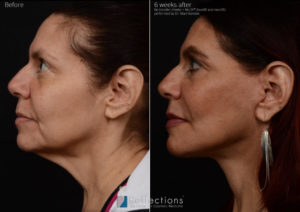 You should plan for a few days of rest immediately following your procedure. You will leave the office with a temporary compression garment that you will not remove for two days. You will follow up with the doctor on the day after surgery to have the temporary compression garment changed and to be fitted for a compression garment that will be worn only at night starting about 48 hours after surgery. This will help minimize swelling and speed up the recovery process. You will wear this until the night after your one-week follow-up visit. Most patients feel “restaurant ready” and comfortable returning to their normal activities around 7 days after surgery. Exercise and strenuous activity must be avoided for 14 days. Bruising and swelling are usually minimal. During the days when patients might experience bruising, makeup can be worn to disguise the discoloration.
You should plan for a few days of rest immediately following your procedure. You will leave the office with a temporary compression garment that you will not remove for two days. You will follow up with the doctor on the day after surgery to have the temporary compression garment changed and to be fitted for a compression garment that will be worn only at night starting about 48 hours after surgery. This will help minimize swelling and speed up the recovery process. You will wear this until the night after your one-week follow-up visit. Most patients feel “restaurant ready” and comfortable returning to their normal activities around 7 days after surgery. Exercise and strenuous activity must be avoided for 14 days. Bruising and swelling are usually minimal. During the days when patients might experience bruising, makeup can be worn to disguise the discoloration.Our physicians have a long history of making recoveries as comfortable and easy as possible. Every care will be taken to ensure your discomfort and downtime are minimized while your results are maximized.
- What is the pain level during recovery from a lower facelift?
With most of the surgeries we perform, there is usually very little discomfort afterward. Most patients will take pain medication for 1 to 3 days following surgery to control any discomfort. You can expect that you will feel tightness along your jawline and in your lower face following the lower facelift procedure, but it will come to feel natural within a few days after surgery.
- What kind of scarring should I expect from a lower facelift?
Our physicians believe natural-looking results include discreet incisions well disguised in natural folds. Artful placement of incision lines, a gentle surgical technique, and skilled suturing are key in minimizing scar appearance.
For more in-depth information about the healing process after facial plastic surgery, please visit our healing after facial surgery page.
- Will I have to go under general anesthesia?
One of the greatest advantages our facial plastic surgery team offers is the ability to forgo general anesthesia, which poses additional risks and concerns for many patients. Instead, our patients enjoy a local anesthesia experience that can only be found at Reflections, which we refer to as Comfort Calm™ Local Anesthesia. Patients are comfortable and relaxed, with no sensation other than light pressure or touch during the procedure. We offer the option to watch television, listen to your favorite music, or even take a nap during the procedure, whichever makes you feel most comfortable.
- What risks or complications are possible with a Facelift?
 We pride ourselves on our safety record. Your plastic surgeon will make sure to go through all of the potential risks with you and answer any questions you have about your specific situation. Each patient is different, and we want to be able to speak to your specific health concerns individually. However, you should know Reflections is meticulous and has an excellent safety record.
We pride ourselves on our safety record. Your plastic surgeon will make sure to go through all of the potential risks with you and answer any questions you have about your specific situation. Each patient is different, and we want to be able to speak to your specific health concerns individually. However, you should know Reflections is meticulous and has an excellent safety record. - What happens during the lower facelift procedure?
After you have relaxed with Comfort Calm Anesthesia™ in our private surgical suite, your surgeon will make small incisions following the natural crease where the ear and cheek meet, following the curve of the ear back and around. First, muscles along the jawline are lifted into a more youthful position. Then fat is recontoured across the lower cheeks. Finally, he will remove any excess skin if needed and then suture the incisions. The whole procedure usually takes about 60 – 90 minutes.
- Will my results from a lower facelift last?
By addressing the underlying structural changes caused by the aging process, a lower facelift makes changes that will ensure you’ll always look better than if you hadn’t had the surgery at all. Over time, you may find great benefit from procedures, which before your lower facelift, would have given only minimal to negligible results.
- How long does a facelift last?
There isn’t an exact answer to the question regarding how long your facelift results will last. The area covered and the technique adopted by your surgeon play a major role in the results as well as how long they last. On average, facelift results will last a minimum of 5 years even when aging continues. After 10 years, you may see some changes in your face that would require some work like wrinkles and sagging skin. These signs usually begin on the neck and later, on your jowls.
- How long does it take to recover from a facelift?
A facelift is major surgery and once you have decided to undergo the procedure, you must want to know everything about the surgery itself as well as the recovery period. Facelift recovery varies from one patient to another since everybody’s body heals differently and it depends on several factors. The most important, though, is to follow the aftercare instructions of your surgeon carefully. Most people are able to feel good enough to return to their normal activities within 2 weeks of their surgery.
The first week after your facelift surgery, you will be mostly resting. This is the time when the medication will make most patients feel tired and nauseous. Even though there is still swelling and bruising by the end of the week, most people are able to walk around by the second day after their facelift surgery. The second stage in facelift recovery lasts from 7 to 14 days and some patients feel sensations of numbness, tingling or burning caused due to the swelling and bruising. This will be minimal by the 3rd week. By this time, the incisions will begin to look better as well and any puckering will begin to settle down. Some areas may still look tight, but mostly you will feel and look better by the end of the month.
- Are facelift scars visible?
Most patients wish to retain their youthful appearance for as long as possible. Early signs of aging can be eliminated with non-invasive procedures like laser therapy or Botox, but after some time, when the definition of your face and neck softens, these procedures may not be as effective. With a natural-looking facelift, you can restore your youthful facial definitions.
During your facelift, small incisions are made within the natural creases of facial features like the ears and scalp. Any loose fat and muscles are returned to their youthful position, the skin is brought back to a higher position, and any excessive skin is trimmed. The underlying structure is rebuilt, which allows the skin to be restored to a smooth position across your jawline and lower cheeks. This leads to natural-looking facelift results rather than a pulled appearance that has kept many people away from this beneficial surgical procedure.
One of the main reasons why you should choose your facelift surgeon carefully is that your results will correlate directly to your surgeon’s skill and experience. A surgeon who understands how important it is for you to appear naturally-rejuvenated will make sure the incisions are well disguised within the natural folds of your face. In addition to the discreet placement of incisions, your surgeon should be skilled in the facelift technique as well as with the suturing procedure. It is natural for any patient to be worried about scarring from a facelift. However, in the hands of an experienced and skilled surgeon, any visible signs of having undergone a facelift are greatly minimized. Your surgeon can also recommend skin treatments to reduce the appearance of scarring.
- How much does a facelift cost?
With a facelift procedure, you can reverse the harmful effects of time, as well as years of exposure to the elements. Also known as rhytidectomy, this procedure can help to reduce the appearance of facial wrinkles and other aging signs. This is done by lifting and tightening the underlying muscles of your face to achieve the desired contours and youthful appearance. Since everybody faces different degrees of changes to their face, the amount of correction required also varies.
There are several factors that affect the cost of your facelift surgery including:
- Type of facelift – There are different kinds of facelift procedures that are designed to address specific aging signs and improve the appearance of some targeted features. Usually, a traditional full facelift will cost you more than a mid-facelift or a mini facelift, which requires smaller incisions.
- Type of anesthesia – Certain types of facelift will require either local or general anesthesia. General anesthesia will cost more; also, different anesthesiologists have varying fees.
- Facelift technique – Your cost will be higher for an advanced method like the endoscopic facelift because of additional tools and technologies.
- Skill and reputation of your surgeon – Highly-respected surgeons who have undergone advanced training have a higher fee than surgeons who are less experienced. When choosing your facial cosmetic surgeon, cost should not be the most important factor, but rather their reputation and skills.
- Additional procedures – Many people combine other procedures with their facelift to get comprehensive results.
Other than this, the location of your chosen practice will also affect the cost of your facelift surgery. It’s also important to remember that facelift is an elective surgery and your insurance will not cover it; however, most practices offer excellent financing options. On average, a facelift procedure costs around $6,000, which does not include associated costs like anesthesia, preparatory tests, and prescriptions. You’ll get a full estimate of these costs during a consultation.
- How can you make your results last longer?
There are several reasons besides genetics that lead to your facelift results not lasting long. Your results can last longer with some factors like taking the right diet, changing your lifestyle, stop smoking and avoiding sun exposure. These changes also make the quality of your life better.
When you begin to see any signs of change when your facelift results begin to diminish, you can resort to various natural facelift methods like injectables and CO2 laser treatments. Most changes involving sagging skin are usually in the neck area and an alternative to a lower facelift, like a laser treatment, will offer skin tightening. Together, these are procedures that reduce wrinkles and boost collagen production may help you retain your facelift results longer.
Sources:
- https://www.plasticsurgery.org/cosmetic-procedures/facelift
- https://www.smartbeautyguide.com/procedures/head-face/facelift/
- https://www.fda.gov/cosmetics/cosmetic-products/wrinkle-treatments-and-other-anti-aging-products
- https://www.ncbi.nlm.nih.gov/pmc/articles/PMC5698509/
- https://www.mayoclinic.org/tests-procedures/face-lift/about/pac-20394059
- https://www.webmd.com/beauty/webmd-medical-reference-collaboration-cleveland-clinic-cosmetic-procedures-facelifts#1
- https://medlineplus.gov/ency/article/002989.htm
- https://www.healthline.com/health/face-lift
- https://www.verywellhealth.com/traditional-face-lift-stepbystep-2710046
- https://emedicine.medscape.com/article/1294682-overview
- https://healthy.kaiserpermanente.org/health-wellness/health-encyclopedia/he.face-lift-rhytidectomy.tf6232

Dr. Mitchell Chasin is a Cosmetic & Laser Physician at Reflections Center. Dr. Chasin believes strongly that the best cosmetic physicians are those who are dedicated to mastering their craft through continuing education and collaboration with the industry’s top doctors.







